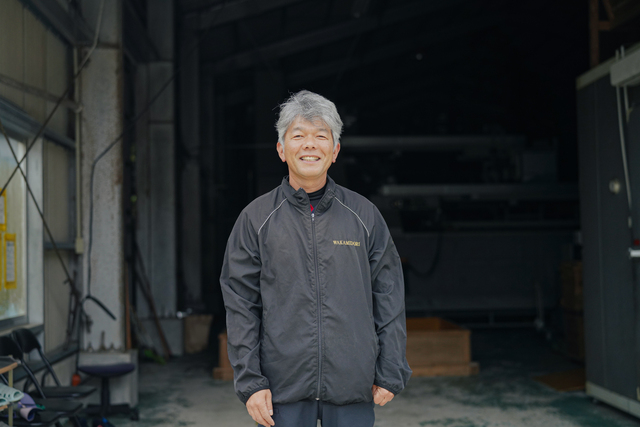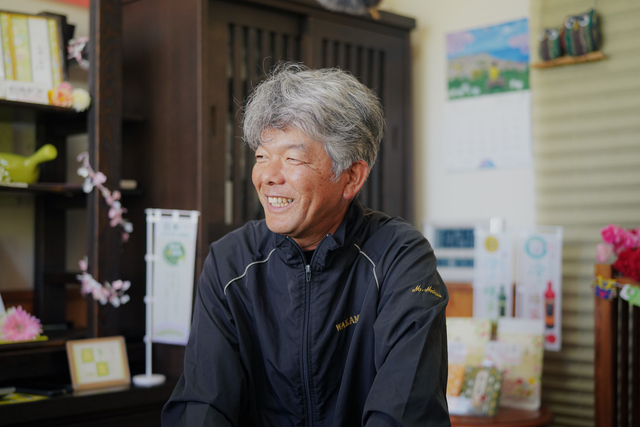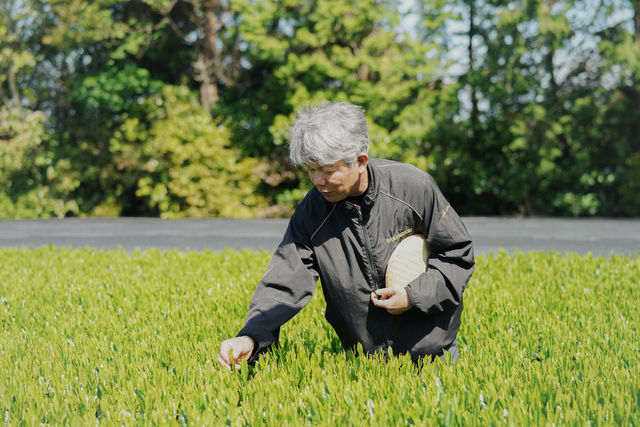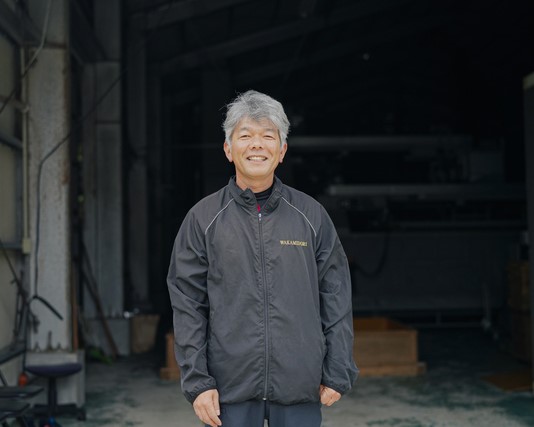When one hears the word “Japanese tea,” Shizuoka and Kyoto come to mind. However, “Sonogicha” from Higashisonogi, Nagasaki Prefecture, is slowly gaining attention from all over Japan. We visited Mr. Masatoshi Matsuo of “Chayu,” a tea farmer who is also actively trading with foreign countries, to learn more about the appeal of Sonogi tea, which continues to spread from Nagasaki to Japan and overseas.

Nagasaki’s Japanese tea is the best in Japan
Nagasaki is located in the center of Nagasaki Prefecture. Higashisonogi, overlooking the calm waters of Omura Bay, is a town blessed with scenic spots and abundant nature, including the valley “Ryutosen” (Dragon’s Head Spring). As you drive into the mountains, you will see tea plantations all around. The ” Sonogicha ” tea grown on the slopes with a mild climate and refreshing sea breezes is now attracting increasing attention in Japan, having won the top prize at a national tea fair for four years in a row.
What is “Sonogicha,” which accounts for about 2% of the nation’s production?
Japanese tea is usually called “sencha,” a thin needle-shaped tea, but “Sonogicha” produced here in Higashisonogi is mostly steamed Tamaryokucha, a rounded tea. It is also called “Guricha” (meaning “green tea” in Japanese) because the tea leaves are curved in the shape of a Japanese “kodama” (a Japanese jewel), and it has a mellower taste with less astringency than sencha. The flavor is extracted as the tea leaves slowly open up in the hot water, allowing the user to enjoy the changes in flavor and aroma each time it is poured.

In recent years, Sogicha tea has consistently ranked high at Japanese tea fairs throughout Japan, and one tea farm in particular that has won the Agriculture, Forestry, and Fisheries Award, the Emperor’s Cup, and the Grand Prize at the Japan Tea Awards is Chayu, a farm run by the second generation Masatoshi Matsuo and his wife.
At the age of 35, he took over the family business and became a tea farmer.
The farm is located at an elevation of 400 meters above sea level, on a mountain slope overlooking Omura Bay in the distance. The tea fields of Chayu, spread out on the slopes of a mountain overlooking Omura Bay in the distance, were full of lush green tea buds that were just about to be harvested. Masatoshi’s father, Michio, planted tea trees here in 1970. Since then, he has been growing and producing Japanese tea. Masatoshi’s life surrounded by tea trees made him vaguely think that he would someday be involved in tea production as well. After attending a prefectural agricultural high school, he returned to his hometown after two years of training in tea production at the National Vegetable and Tea Research Institute in Shizuoka. In 2004, at the age of 35, he took over the tea farm and established Chayu, a company that handles everything from production to sales.
Drawing out the potential of the tea leaves by being close to nature
Most of the teas produced at Chayu are steamed Tamaryokucha, as mentioned above. Since there is no “rubbing” process to shape the tea leaves into a needle shape, the tea leaves are round. The tea leaves are rounded and rounded because there is no “rubbing” process to shape the tea leaves into a needle-like shape. Masatoshi says, ” I want to bring out the full potential of the tea leaves in terms of shape, taste, and aroma.” As Masatoshi says, Chachatomo’s steamed Tamaryokucha has a soft, sweet taste with little bitterness and bitterness, and is known for its smooth, easy-throating flavor.
The tea leaves are not overworked, and the tea leaves have a soft, sweet, and smooth taste. The tea fields are fertilized with organic materials such as bone meal and rapeseed oil pomace, and as little chemical fertilizers and pesticides are used as possible. Although this means that damage from animals and vermin is unavoidable, the soil is soft and fertile, rich in earthworms and microorganisms, as a result of mixing in the organic fertilizers.

Tea cultivation based on the environment of each field
Furthermore, the unique topography of Higashisonogi, surrounded by the sea and mountains, brings diversity to the flavor of the tea. In Higashisonogi, where there is not much flat land, the temperature and humidity vary slightly depending on the difference in elevation, from the sea coast to the mountain slopes. Masatoshi says, “We can’t mass-produce, but we can have fun pursuing the flavor of each field through trial and error. We try to make better tea every year, but it is difficult to get 100 points. I can’t beat the power of nature,” he says with a gentle smile.
Rare “Asatsuyu” tea that has won numerous awards
Currently, there are a total of eight varieties of tea grown at Chayu. Among them, ” Asatsuyu,” made from a variety called “Asatsuyu,” which is characterized by its sweetness and flavor with little bitterness and astringency, is the signature product of Chayu. Asatsuyu was originally selected from a native variety of Uji, Kyoto, and registered as a variety in 1953, but it is extremely rare, with only about 1% of all tea plantations in Japan cultivating it.
The warm climate here in Higashisonogi is also suitable for Asatsuyu, but it is one of the most difficult varieties to cultivate and produce. Masatoshi’s Asatsuyu has won numerous awards for its high quality, including the Minister of Agriculture, Forestry, and Fisheries Award,theEmperor’s Cup, and the ” Japanese Tea Award, ” in which the general public determines the quality of the tea.

Tea that you can drink every day and never get tired of it.
While producing unique teas such as “Asatsuyu,” Chayu aims to create a natural environment where tea is a part of daily life. Masatoshi says, “It is great to make award-winning teas that are satisfying after just one cup, but we also want to make familiar teas that people will want to drink every time they notice them. Masatoshi also actively holds events related to Japanese tea in hopes that people will become more familiar with Japanese tea in these days when many people are becoming less interested in Japanese tea.
Seasonal Tea Ceremonies
Tea parties have been held regularly in Nagasaki and Tokyo for the past 18 years. Along with homemade sweets made with local ingredients, he has been telling stories about the scenery of tea picking while brewing tea. He says, “I think it is important for people to know that tea is made in such a place by such people, rather than just drinking the tea that is served in front of them. Once people learn about the tea, they will become more interested in Japanese tea, and some of them will say they want to drink it.
Spreading the Appeal of Japanese Tea Abroad
In 2016, the company launched the ” Japanese Tea Germany Project ” with the philosophy of “bringing authentic Japanese tea to Germany. In Germany, where tea culture, including herbal tea, is deeply rooted, imports of Japanese tea have increased significantly in recent years, coupled with a growing boom in Japanese food. It is now the second largest exporter of tea from Japan after the United States.
Japanese tea exports in 2021 (from the website of the Japan Tea Export Promotion Council)
In the project, Japanese tea that meets the EU’s strict standards is introduced to the market through surveys of local residents’ understanding of and preference for Japanese tea at tea stores, cafes, and restaurants throughout Germany. In Munich and other cities, Masatoshi often holds tea parties where he brews Japanese tea in front of the guests and talks about Japanese tea.
Masatoshi says, “So-called ‘green tea’ is sold everywhere, but it is often not a proper Japanese tea. But from our point of view, we want people to know and drink real Japanese tea. Otherwise, the tea we have worked so hard to produce will never reach anyone. It is with this in mind that we started our activities overseas as well,” says Masatoshi. Masatoshi says that his activities in Germany have gradually expanded, and when he held a tea party with the theme of pairing Japanese tea with a local course meal, the event was so popular that tickets were sold out immediately.
We paired ‘Asatuyu’ mizudashi with a course meal, which went surprisingly well together,” he said. And when I hear people say, ‘I want this tea so I can sell it,’ it makes me think that all those days of hard work in the tea fields were for this moment. It’s a new challenge that we can’t reach just by making tea leaves. I would like to continue to create more and more opportunities to share with our customers what we have worked so hard to produce.

What is the future of Japanese tea?
Our job is not only to make Japanese tea leaves, but also to have people drink them, ” says Masatoshi. It is precisely because of this that Masatoshi feels a sense of crisis over the current “shift away from Japanese tea” and has been involved in a variety of activities. What he has realized is that it is not about promoting the correct way to brew and drink Japanese tea, but about how to enjoy Japanese tea. In order to do so, he says, it is necessary to have the courage to ignore the stereotypes that have been taken for granted in the tea industry.
The Tea Industry Enters a New Phase
The tea industry needs to propose a way to drink tea that tastes good without the trouble of brewing it in a teapot, although of course brewing tea in a teapot is wonderful. I don’t think there is any such thing as ‘first tea’ being good and ‘second or third tea’ not being good. Farmers work very hard to produce each type of tea, and there are tastes that are only suited to the tea leaves that are available at the time of harvest. What is the ideal Japanese tea for today’s life and for today’s people? I think it is time for the tea industry to consider this question.
Continuing to Pursue the Taste of Japanese Tea
About five years ago, the company began to use the kama-firi method, which used to be popular mainly in Kyushu. Today, production of kamabai tea has declined to the point where it is said to account for less than 0.03% of all Japanese teas, but its distinctive flavor and aroma, known as kamaka, still enjoys strong popularity.
Masatoshi says, “I want to try various things in order to create ‘delicious’ products that fit the future. Masatoshi’s vision of the future of Japanese tea is full of new possibilities.
One single type of tea tree can be transformed into such a wide variety of flavors just by changing the time of harvest or the production method. There is no such drink without any additives. There is nothing else I can do except make tea. That’s how much I love tea.
Masatoshi’s words and the look in his eyes show a joy that goes beyond his sense of mission to promote Japanese tea in daily life, to bring Japanese tea into people’s lives with love.




